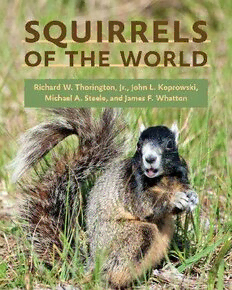
Squirrels of the world PDF
Preview Squirrels of the world
squirrels of the world Squirrels of the World Richard W. Thorington, Jr., John L. Koprowski, Michael A. Steele, and James F. Whatton THE JOHNS HOPKINS UNIVERSITY PRESS BALTIMORE This book was brought to publication through the generous contri- Title Page Illustrations: (left to right) Tamiops mcclellandii, butions of the Smithso nian Institution, Wilkes University, and the photo courtesy Nick Baker, www.ecologyasia.com; Sciurus University of Arizona. granatensis, photo courtesy Caroline M. Thorington; Marmota caligata, photo courtesy U.S. Fish and Wildlife Service; © 2012 The Johns Hopkins University Press Sciurus niger cinereus, photo courtesy Cynthia C. Winter. All rights reserved. Published 2012 Printed in China on acid-free paper 9 8 7 6 5 4 3 2 1 The Johns Hopkins University Press 2715 North Charles Street Baltimore, Maryland 21218-4363 www.press.jhu.edu Library of Congress Cataloging-in-Publication Data Squirrels of the world / by Richard W. Thorington, Jr. . . . [et al.]. p. cm. Includes bibliographical references and index. isbn-13: 978-1-4214-0469-1 (hdbk. : alk. paper) isbn-10: 1-4214-0469-9 (hdbk. : alk. paper) 1. Sciuridae. I. Thorington, Richard W. ql737.r68s68 2012 599.36—dc23 2011030931 A catalog record for this book is available from the British Library. Special discounts are available for bulk purchases of this book. For more information, please contact Special Sales at 410-516-6936 or [email protected]. The Johns Hopkins University Press uses environmentally friendly book materials, including recycled text paper that is composed of at least 30 percent post-consumer waste, whenever possible. contents Preface vii Petinomys 123 Callospermophilus 255 Abbreviations vii Pteromys 128 Cynomys 260 Pteromyscus 131 Ictidomys 268 Taxonomic Introduction 1 Trogopterus 132 Marmota 271 Paleontology 4 Callosciurinae 134 Notocitellus 290 Anatomy 7 Callosciurus 134 Otospermophilus 292 Ecology, Behavior, and Dremomys 153 Poliocitellus 296 Conservation 11 Exilisciurus 158 Sciurotamias 298 Funambulus 161 Spermophilus 300 SPECIES ACCOUNTS Glyphotes 166 Tamias 315 Ratufi nae 23 Hyosciurus 167 Urocitellus 349 Ratufa 23 Lariscus 169 Xerospermophilus 366 Sciurillinae 30 Menetes 172 Sciurillus 30 Nannosciurus 174 Appendix. Representative Skulls Sciurinae 32 Prosciurillus 175 of Each Squirrel Genus 373 Sciurini 32 Rhinosciurus 180 References 403 Microsciurus 32 Rubrisciurus 181 Index 441 Rheithrosciurus 36 Sundasciurus 182 Sciurus 37 Tamiops 195 Syntheosciurus 77 Xerinae 200 Tamiasciurus 78 Xerini 200 Pteromyini 85 Atlantoxerus 200 Aeretes 85 Spermophilopsis 202 Aeromys 86 Xerus 203 Belomys 88 Protoxerini 211 Biswamoyopterus 89 Epixerus 211 Eoglaucomys 90 Funisciurus 212 Eupetaurus 91 Heliosciurus 223 Glaucomys 92 Myosciurus 232 Hylopetes 98 Paraxerus 233 Iomys 106 Protoxerus 246 Petaurillus 108 Marmotini 250 Petaurista 110 Ammospermophilus 250 This page intentionally left blank preface Our objective in writing Squirrels of the World is to provide a within the text. However, at the end of each species account book that exhibits the great diversity of squirrels, describes we supply a reference section, giving a brief citation for the some of their biology, and is illustrated with photographs and publications we have used, which are subsequently cited distribution maps for all species. Unfortunately, photographs in full in the bibliographic section at the back of the book. were not available for all of the squirrel species, despite the The online International Union for Conservation of Nature eff orts of our many photographic collaborators, who contrib- (IUCN) Red List of Threatened Species, version 2010.3, provided uted images of 231 out of the total of 285 species that we rec- information for the conservation status of each species and ognize in this book. In preparing the maps, we discovered many of the range maps. We include the IUCN online refer- that many of the published distribution maps are inaccurate. ence for an individual species account in our book only if Accordingly, we carefully checked the described distribu- we used information from it beyond the conservation status tions of each species and based the maps on documented re- and the map. This format should allow interested readers cords of occurrence. Our knowledge of species and distribu- access to the rich literature on squirrels. tions continues to change, but we have endeavored to provide Normally a mammalian account includes illustrations of the most accurate assessments available. the skull. Instead of this we provide illustrations of the Our format is straightforward, starting with the scientifi c skulls of most genera of squirrels in an appendix. We hope name, followed by the name of the person who described it this will assist in the identifi cation of museum specimens, and the date of the description, the common name, a brief fi eld discoveries, and fossils. description of the species, including some measurements, and its overall distribution. In the section on geographic vari- We are grateful for our assistants who have helped us pre- ation, we provide the scientifi c names of the subspecies we pare this book, particularly Paula W. Bohaska of the Smith- recognize, their geographic range, and characteristics used to sonian Institution, Maressa Takahashi of Columbia Univer- distinguish them. In some species, the subspecies are remark- sity, Jennie Miller of Yale University, Hsiang Ling Chen and ably distinct from one another. Our goal is that our readers Katharine Derrick of the Conservation Research Laboratory will be able to identify the species and subspecies of the squir- at the University of Arizona, and Melissa Bugdal of W ilkes rels that they observe. We then comment on the conserva- University. tion status, although frequently the abundance of a species is Abbreviations poorly known. Finally, we supply a brief description of the preferred habitat of the species, and a summary of what is HB head and body length measurement known about its natural history. We hope that the extreme HF hind foot measurement brevity of natural history information for many species will IUCN International Union for Conservation of Nature serve to stimulate further research. T tail length measurement This book is a compilation from many sources. In order to TL total length facilitate reading, we do not include citations to our sources This page intentionally left blank squirrels of the world
